This story is based on Ralph Cartwright’s presentation to APS Sutherland Group in June 2019 on botanical trivia of Hawaii with photos from his trip and text compiled from various sources.
Hawaii’s volcanic origins
The American state of Hawai`i includes 137 islands, the largest known as Hawai`i. Of the 8 main islands, 7 are inhabited. They lie in the middle of the North Pacific, about 3,000 km from the nearest continent. The islands are the tops of massive volcanoes, the bulk of which lie below the sea surface.
This chain of islands developed as the Pacific Plate moved slowly northwestward over a hotspot in the Earth’s mantle at a rate of 50 km per million years. The southeast island is still volcanically active, whereas the islands on the northwest end of the archipelago are older and typically smaller, due to longer exposure to erosion. The only active volcanism in the last 200 years has been on Hawaiʻi, where Kilauea has been erupting nearly continuously since 1983. The Hawaiian volcanoes are composed almost entirely of the igneous rock basalt. Due to the volcanic activity, the soil is quite fertile.
A mix of endemic and introduced species
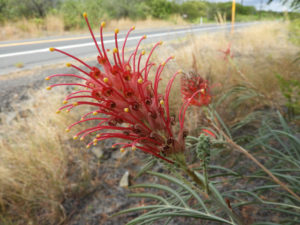
Around 95% of plants found on the islands now are thought to be non-indigenous. Since human settlement first by Polynesians and later by early European explorers, food plants and animals have been introduced. These included species such as rats and pigs that have preyed on native birds and invertebrates that initially evolved in the absence of such predators. The arrival of European settlers had a more significant impact, with the promotion of large-scale single-species export agriculture such as sugar cane, pineapples and later livestock grazing.
Introduced Grevillea species with roadside grasses
Endemic species
Vaccinium reticulatum
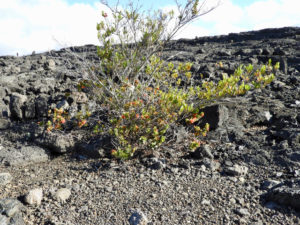
Vaccinium reticulatum, or ʻōhelo ʻai, is one endemic plant. It is common around Kilauea at an altitude of around 1,200 m. It is a member of the Ericaceae family, found most commonly in acid and infertile growing conditions. It grows on lava flows and freshly disturbed volcanic ash. Adaptations to volcanic activity include the ability to survive ash falls.
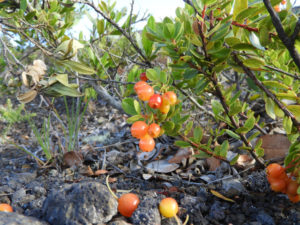
It is a shrub usually 0.1–1.3 m tall, with evergreen leaves, spirally arranged, leathery, oval, 1–3 cm long, red when freshly emerging, then green or green with reddish patches. The flowers are bell-shaped, 8–12 cm long, variable in color, usually red, but can be yellow or pink. The fruit is an edible berry 8–14 mm diameter, ranging in colour from blue or purple to red, orange or yellow. The berries are an important food source for the nēnē, a goose which is the official state bird and endemic to the islands, and the seeds are dispersed in the birds’ droppings.
Metrosideros polymorpha
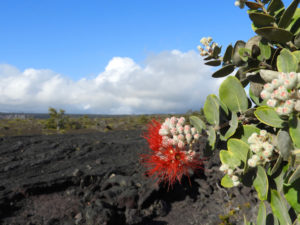
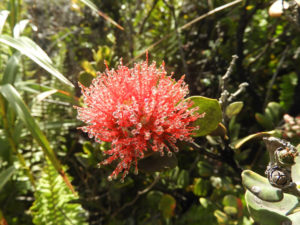
Metrosideros polymorpha, ʻōhiʻa lehua, is another endemic plant found at Kilauea. A flowering evergreen in the Myrtaceae family, it is related to our bottlebrushes. It is a pioneer plant and grows directly on basalt around the lava fields where it is found as a small shrub, but in favourable positions, it can grow to 25 m. Most of the ones seen around Kilauea were up to 3 m tall. It is still abundant, but many introduced plants including Grevillea robusta compete with it and a newly identified fungus is also causing sudden death syndrome in some forested areas.
The lehua has adapted to periodic exposure to the harmful volcanic gases seeping up from below the earth by being able to quickly close the stomata in their fleshy leaves. When the wind changes, the pores re-open allowing the leaf to breath again.
Argyroxiphium sandwicense
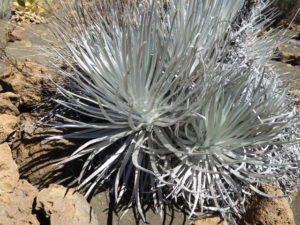
Mauna Kea is the highest volcano in Hawaii at over 4,000 m. Near a small reserve next to the visitors centre was Argyroxiphium sandwicense, the Hawai’i silversword. This is a slow growing plant which can take up to 40 years to send up a single 2 m flower spike and they only flower once. There are reputed to be only 40 plants left in the wild. They grow at high altitudes, on poor soils and are subjected to extremes of weather.
Like the native goose, it has been decimated by introduced animals, in this case sheep and goats who browsed it almost to the verge of extinction. Most of the feral animals on the mountain have now been eradicated and efforts are being made to revegetate areas like the reserve. The leaves are covered with layers of silvery hairs which reflect sunlight and help conserve moisture.
Samanea saman
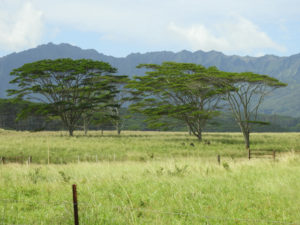
Samanea saman, MonkeyPod Tree, is widespread throughout the islands and is yet another introduced species of rainforest tree, this one native to Central and South America. It is thought it was introduced by ranchers as a shade tree for their beef cattle, who also ate the prolific seed pods when they fell from the tree. It is a fast growing tree, with a wide canopy. In Venezuela, a 20 m specimen is recorded as having a crown diameter of around 60 m and a trunk of nearly 3 m diameter. It is an easily worked, and durable hardwood, popular with wood carvers and furniture makers. In tropical India, the common name is rain tree. Because of the massive crown, cicadas can live in great numbers, feasting on the leaves and their honeydew-like discharge can seem like rain.
Invasive species from Australia and beyond
The Hawaii Invasive Species Council website lists 75 species for which they have funding for prevention, control or research, including many plants familiar to Australia. These include a senna, the Australian tree fern and Grevillea robusta which has been deliberately planted since the 1800s as a shade tree for coffee and tea but is now one of Hawaii’s most invasive horticultural plants and now categorised as a “do not plant” species. Other items on the list include pampas grass, gorse, lantana and of course feral deer, feral cats and fire ants.
Elaeocarpus species
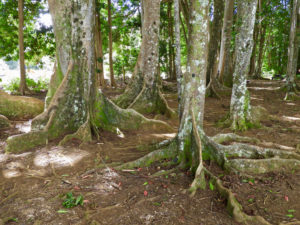
On the island of Kuai’I is a Hindu temple. Next to it is a peaceful grove of some Rudraksha trees, Eleocarpus ganitrus. They are native to the North Indian plains to the foothills of the Himalayas. This grove of 108 trees was planted in 1984 and the trees are now around 15-20 m high. Australian Eleocarpus species include the blueberry ash and the quandong, both with blue fruit, like the Rudraksha.
The legend is that the God Siva looked down upon the Earth and, seeing the sorrowful plight we humans had created for ourselves, wept a single tear. The tear fell from His cheek and upon hitting the ground created the first Rudraksha tree (the word rudraksha means the tear of Siva). Hindus wear beads made from the fruits for protection.
Pennisetum purpureum
Another introduced plant originally brought in as cattle feed from Africa is Pennisetum purpureum – Elephant or Guinea grass. Unfortunately, it is extremely invasive and has taken over the whole island as it can grow to 2 m. Another introduced African grass, originally ornamental, is fountain grass, which while being quite attractive when seen growing on otherwise bare lava fields, is also fire-adapted. It can sustain fires that spread quickly into adjacent areas and its dried leaves increase the intensity of wildfires. After a fire it sprouts faster than native plants.
